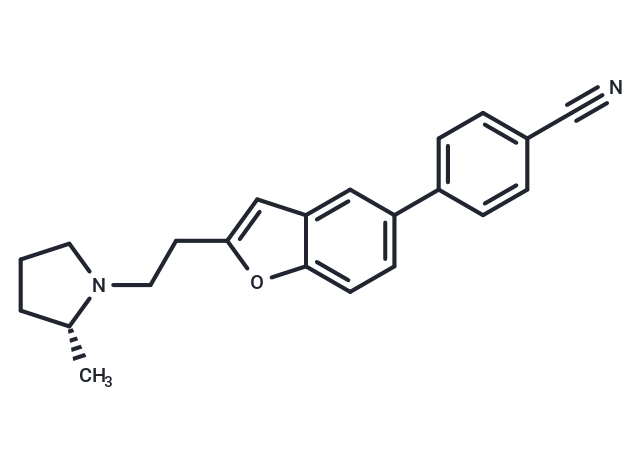Shopping Cart
- Remove All
 Your shopping cart is currently empty
Your shopping cart is currently empty

ABT-239 is a novel, highly efficacious non-imidazole class histamine H3 receptor (H3R) antagonist and also acts as a transient receptor potential vanilloid type 1 (TRPV1) antagonist.

| Pack Size | Price | Availability | Quantity |
|---|---|---|---|
| 1 mg | $40 | In Stock | |
| 5 mg | $97 | In Stock | |
| 10 mg | $163 | In Stock | |
| 25 mg | $329 | In Stock | |
| 50 mg | $495 | In Stock | |
| 100 mg | $695 | In Stock | |
| 200 mg | $965 | In Stock | |
| 1 mL x 10 mM (in DMSO) | $97 | In Stock |
| Description | ABT-239 is a novel, highly efficacious non-imidazole class histamine H3 receptor (H3R) antagonist and also acts as a transient receptor potential vanilloid type 1 (TRPV1) antagonist. |
| In vitro | Perfusing the tuberomammillary nucleus (TMN) with ABT-239 selectively activates c-Fos in the nucleus basalis of Meynert (NBM) and cortex. Moreover, when the TMN is perfused with ABT-239 at a concentration of 10 μM, there is an increase in histamine release from the TMN, NBM, and cortex; however, this effect is not observed in either the striatum or the nucleus accumbens (NAcc). |
| In vivo | ABT-239, administered intraperitoneally (i.p.) at a dosage of 3 mg/kg, markedly delays seizure onset, diminishes behavioral seizures triggered by KA, and lowers the occurrence of head bobbing and forelimb clonus in mice. Additionally, at this dosage, ABT-239 enhances memory by converting a short-term learning event into a long-lasting memory in wild type (WT) mice, albeit not in those lacking histamine. The compound is also found to significantly reduce all stages of neuronal damage. In conjunction, ABT-239 and TDZD-8 (10 mg/kg, i.p.) notably decrease the quantity of pyknotic neurons in the hippocampi of mice. When ABT-239 (1 mg/kg, i.p.) is combined with a sub-therapeutic dose of SVP (150 mg/kg, i.p.), there is a marked decrease in behaviors associated with distress such as immobility, head bobbing, and forelimb clonus. A higher dose combination of ABT-239 and TDZD-8 exhibits the most significant enhancement of Bcl-2 expression and reduction in Bax levels, indicating improved neuronal survival. Additionally, combined administration of ABT-239 (at doses of 1 and 3 mg/kg, i.p.) with nicotine enhances nicotine's beneficial effects on memory acquisition and consolidation, with further improvements observed at lower concentrations of ABT-239 (0.1 mg/kg, i.p.) and nicotine. |
| Molecular Weight | 330.42 |
| Formula | C22H22N2O |
| Cas No. | 460746-46-7 |
| Smiles | C[C@@H]1CCCN1CCc1cc2cc(ccc2o1)-c1ccc(cc1)C#N |
| Relative Density. | 1.18 g/cm3 (Predicted) |
| Storage | Powder: -20°C for 3 years | In solvent: -80°C for 1 year | Shipping with blue ice. | |||||||||||||||||||||||||||||||||||
| Solubility Information | DMSO: 90 mg/mL (272.38 mM), Sonication is recommended. H2O: insoluble | |||||||||||||||||||||||||||||||||||
Solution Preparation Table | ||||||||||||||||||||||||||||||||||||
DMSO
| ||||||||||||||||||||||||||||||||||||

Copyright © 2015-2025 TargetMol Chemicals Inc. All Rights Reserved.